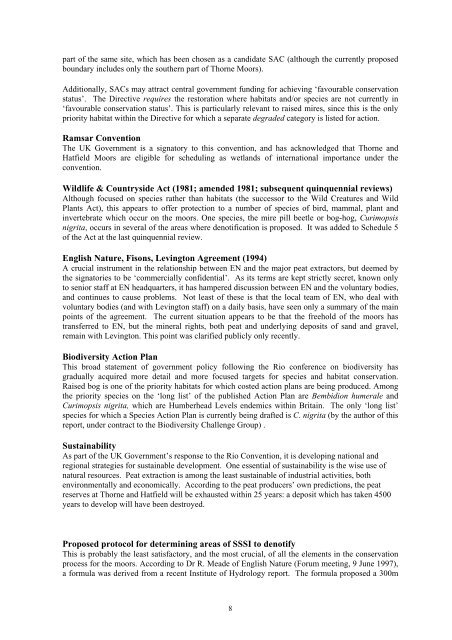free download - Thorne & Hatfield Conservation Forum
free download - Thorne & Hatfield Conservation Forum
free download - Thorne & Hatfield Conservation Forum
You also want an ePaper? Increase the reach of your titles
YUMPU automatically turns print PDFs into web optimized ePapers that Google loves.
part of the same site, which has been chosen as a candidate SAC (although the currently proposed<br />
boundary includes only the southern part of <strong>Thorne</strong> Moors).<br />
Additionally, SACs may attract central government funding for achieving ‘favourable conservation<br />
status’. The Directive requires the restoration where habitats and/or species are not currently in<br />
‘favourable conservation status’. This is particularly relevant to raised mires, since this is the only<br />
priority habitat within the Directive for which a separate degraded category is listed for action.<br />
Ramsar Convention<br />
The UK Government is a signatory to this convention, and has acknowledged that <strong>Thorne</strong> and<br />
<strong>Hatfield</strong> Moors are eligible for scheduling as wetlands of international importance under the<br />
convention.<br />
Wildlife & Countryside Act (1981; amended 1981; subsequent quinquennial reviews)<br />
Although focused on species rather than habitats (the successor to the Wild Creatures and Wild<br />
Plants Act), this appears to offer protection to a number of species of bird, mammal, plant and<br />
invertebrate which occur on the moors. One species, the mire pill beetle or bog-hog, Curimopsis<br />
nigrita, occurs in several of the areas where denotification is proposed. It was added to Schedule 5<br />
of the Act at the last quinquennial review.<br />
English Nature, Fisons, Levington Agreement (1994)<br />
A crucial instrument in the relationship between EN and the major peat extractors, but deemed by<br />
the signatories to be ‘commercially confidential’. As its terms are kept strictly secret, known only<br />
to senior staff at EN headquarters, it has hampered discussion between EN and the voluntary bodies,<br />
and continues to cause problems. Not least of these is that the local team of EN, who deal with<br />
voluntary bodies (and with Levington staff) on a daily basis, have seen only a summary of the main<br />
points of the agreement. The current situation appears to be that the <strong>free</strong>hold of the moors has<br />
transferred to EN, but the mineral rights, both peat and underlying deposits of sand and gravel,<br />
remain with Levington. This point was clarified publicly only recently.<br />
Biodiversity Action Plan<br />
This broad statement of government policy following the Rio conference on biodiversity has<br />
gradually acquired more detail and more focused targets for species and habitat conservation.<br />
Raised bog is one of the priority habitats for which costed action plans are being produced. Among<br />
the priority species on the ‘long list’ of the published Action Plan are Bembidion humerale and<br />
Curimopsis nigrita, which are Humberhead Levels endemics within Britain. The only ‘long list’<br />
species for which a Species Action Plan is currently being drafted is C. nigrita (by the author of this<br />
report, under contract to the Biodiversity Challenge Group) .<br />
Sustainability<br />
As part of the UK Government’s response to the Rio Convention, it is developing national and<br />
regional strategies for sustainable development. One essential of sustainability is the wise use of<br />
natural resources. Peat extraction is among the least sustainable of industrial activities, both<br />
environmentally and economically. According to the peat producers’ own predictions, the peat<br />
reserves at <strong>Thorne</strong> and <strong>Hatfield</strong> will be exhausted within 25 years: a deposit which has taken 4500<br />
years to develop will have been destroyed.<br />
Proposed protocol for determining areas of SSSI to denotify<br />
This is probably the least satisfactory, and the most crucial, of all the elements in the conservation<br />
process for the moors. According to Dr R. Meade of English Nature (<strong>Forum</strong> meeting, 9 June 1997),<br />
a formula was derived from a recent Institute of Hydrology report. The formula proposed a 300m<br />
8


